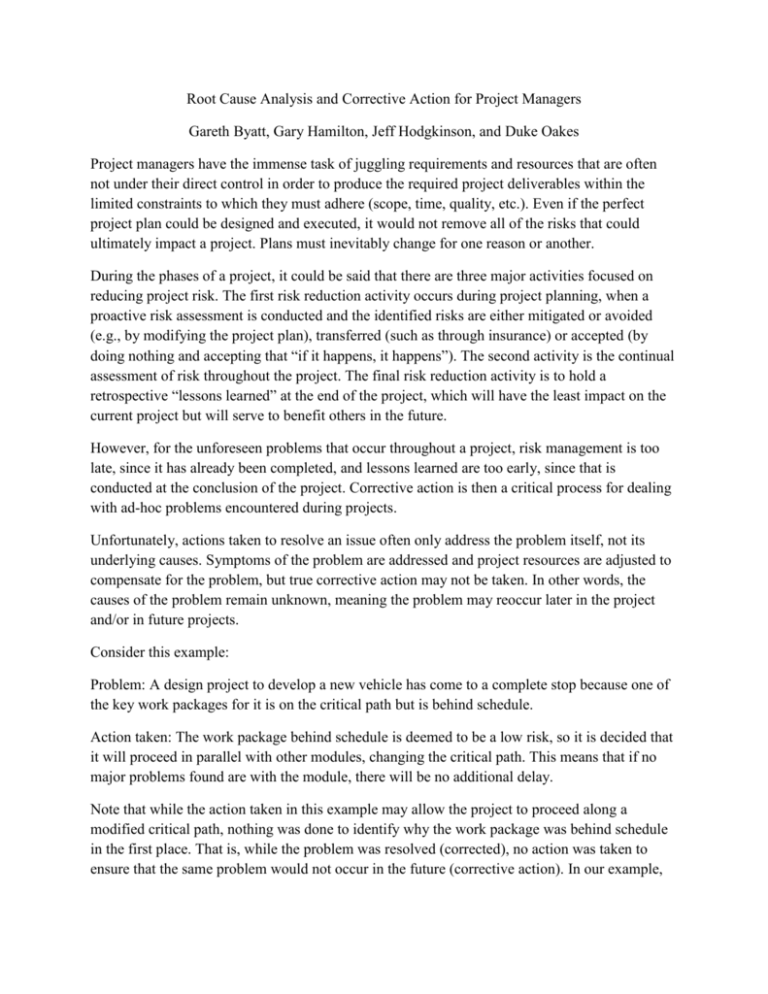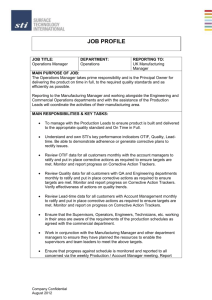Root Cause Analysis and Corrective Action for Project
advertisement

Root Cause Analysis and Corrective Action for Project Managers Gareth Byatt, Gary Hamilton, Jeff Hodgkinson, and Duke Oakes Project managers have the immense task of juggling requirements and resources that are often not under their direct control in order to produce the required project deliverables within the limited constraints to which they must adhere (scope, time, quality, etc.). Even if the perfect project plan could be designed and executed, it would not remove all of the risks that could ultimately impact a project. Plans must inevitably change for one reason or another. During the phases of a project, it could be said that there are three major activities focused on reducing project risk. The first risk reduction activity occurs during project planning, when a proactive risk assessment is conducted and the identified risks are either mitigated or avoided (e.g., by modifying the project plan), transferred (such as through insurance) or accepted (by doing nothing and accepting that “if it happens, it happens”). The second activity is the continual assessment of risk throughout the project. The final risk reduction activity is to hold a retrospective “lessons learned” at the end of the project, which will have the least impact on the current project but will serve to benefit others in the future. However, for the unforeseen problems that occur throughout a project, risk management is too late, since it has already been completed, and lessons learned are too early, since that is conducted at the conclusion of the project. Corrective action is then a critical process for dealing with ad-hoc problems encountered during projects. Unfortunately, actions taken to resolve an issue often only address the problem itself, not its underlying causes. Symptoms of the problem are addressed and project resources are adjusted to compensate for the problem, but true corrective action may not be taken. In other words, the causes of the problem remain unknown, meaning the problem may reoccur later in the project and/or in future projects. Consider this example: Problem: A design project to develop a new vehicle has come to a complete stop because one of the key work packages for it is on the critical path but is behind schedule. Action taken: The work package behind schedule is deemed to be a low risk, so it is decided that it will proceed in parallel with other modules, changing the critical path. This means that if no major problems found are with the module, there will be no additional delay. Note that while the action taken in this example may allow the project to proceed along a modified critical path, nothing was done to identify why the work package was behind schedule in the first place. That is, while the problem was resolved (corrected), no action was taken to ensure that the same problem would not occur in the future (corrective action). In our example, was the module behind due to inadequate capacity of the assigned resources, or for some other reason? Corrective action consists of two major phases: Diagnosis: Performing an investigation to find the root causes of the problem Solution: Taking action to prevent the causes from recurring To provide a more detailed breakdown of these steps, we put forward an example “10-step problem solving model” that we hope will be of use in guiding you through a corrective action process. Steps 1 through 5 are for problem diagnosis, and 6 through 10 for solution implementation. 1. Define the Problem: What occurred, where and when was it identified, when did it begin, and how significant is it? 2. Understand the Process: What were the process steps that should have been carried out before the problem was found? 3. Identify Possible Causes: If they did not occur as planned, which of the process steps could have caused the problem? 4. Collect Data: What information could indicate which of the possible causes actually occurred in a way that would create the problem? 5. Analyze Data: What does the data indicate about which of the possible causes did or did not contribute? 6. Identify Possible Solutions: What changes to the processes of project planning and execution might keep those processes from failing in the future? 7. Select Solutions: Which of the possible solutions identified are the most viable? 8. Implement Solutions: Plan and carry out the selected solutions. 9. Evaluate the Effects: Were the solutions implemented and have they worked? 10. Institutionalize the Change: Update project management guidelines and tools to ensure that future projects are carried out in alignment with the improved processes. Note that steps 1 through 5 are typically done iteratively, until the causes found are at a depth sufficient to prevent recurrence. For example, if on a software project testing, delays are due to inadequate capacity of the testing software, the reason for the capacity problem would need to be determined in order to prevent such a failure in the future. Of course, it is not necessary to carry out this level of investigation and action for every problem that occurs during a project, so an important component of the corrective action process is risk assessment and agreement on a sensible course of action. That is, for each problem that occurs, the relative magnitude and likelihood as part of a risk assessment should be considered before assuming root cause analysis is required. There are many barriers that prevent corrective action from being carried out effectively. We have already alluded to … a lack of guidance … a process … for carrying it out. That’s the purpose of steps 1 through 10. Other barriers and resulting imperatives for project managers include: There is often a tendency for a single individual to try to perform the investigation and solve the problem without help. However, project failures are often the result of incremental variations within multiple processes, and a single individual is unlikely to be sufficiently familiar with all processes to be able to evaluate them effectively and without bias. Therefore, project managers must ensure that they involve multiple players in the diagnosis of complex problems. They need to encourage their team to “put their hand up for help”. In the rush to solve problems, people make assumptions and jump to causes or solutions without having data to back them up. This leads to tampering with processes, which can result in further problems. Project managers need to be certain that adequate information is available before deciding which actions to take. Corrective action often has a negative connotation in organizations, which means people don’t look forward to being involved. However, many studies have shown that humans and organizations learn more from their failures than from their successes, so corrective action needs to be viewed as simply the process of learning more about how processes actually operate. Project managers need to employ positivity when assessing the need for corrective action and putting the case forward to do it. Corrective action is seen as something that is in addition to the “regular work”, rather than as part of effective business management, as indicated by the Plan-Do-Check-Act cycle. Project managers who emphasize the PDCA cycle as part of day-to-day thinking, as well as during major milestone reviews, will help others see the more complete picture of their roles. It is certainly an embedded part of Quality Management. Many organizations want to automatically assign the cause of all problems to human error. The problem with this is that it is insufficient to provide identification of solutions, since the cause for that human error would need to be known. Many of the causes of human error turn out to be deficiencies in information, equipment, and management processes. Project managers who focus on process deficiencies rather than blaming people will find that others are more willing to dig down to the real causes of problems. There are also challenges specific to project management which serve to make the activity of corrective action more difficult. These include: Many projects involve multiple organizations, each a separate legal entity having unique knowledge/skills for which they are being contracted. This means players may try to protect their own turf (think of the BP disaster in the Gulf, and how the various contractors blamed each other), making the truth hard to find. Project personnel may only consider the current project, rather than future projects, as potential beneficiaries of corrective action. The reality is that all players should be able to learn from investigations and often carry that knowledge into future projects. Similarly, due to the fact that each project has an end-point, it may be difficult to do a full-on evaluation of effectiveness. The value of solutions may only be appreciated in the course of future projects. Another significant advantage of developing better root cause analysis skills within the project team is that such thinking is fundamental for risk management, quality management and the creation of a “learning culture.”





